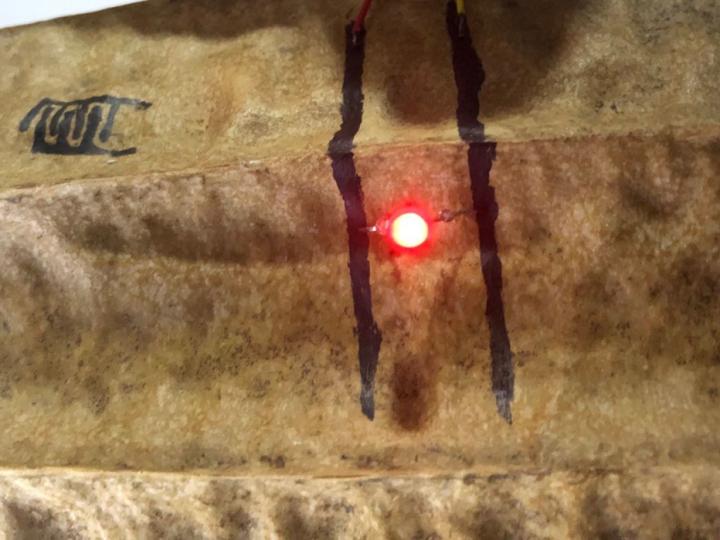A better pen-and-ink system for drawing flexible circuits

A pen containing conductive ink can draw circuits on a variety of surfaces -- even a loofah (seen here).
Credit: Adapted from ACS Applied Electronic Materials 2020, DOI: 10.1021/acsaelm.0c00866
Conductive ink is a great tool for printing flexible electronic circuits on surfaces. But these inks can be costly, they do not work on some materials, and devices to apply them can plug up. Now, scientists report in ACS Applied Electronic Materials that they have developed inexpensive conductive inks for clog-free ballpoint pens that can allow users to “write” circuits almost anywhere — even on human skin.
Flexible electronics are widely used in applications such as biosensors, electronic skin and energy storage. Recent advances to produce such devices include pens that can draw circuits on surfaces, without the need for a printer. These pens can write on a variety of textures, and some can even draw on rough or irregular surfaces unsuitable for printing.
However, it’s difficult to make ballpoint pens that maintain good circuit-writing performance because the tips can clog. Another challenge is that the metal inks typically used in these systems are expensive to make. And it’s unclear how stable these pens and inks are over time. So Yu Liao, Jun Qian and colleagues set out to design a cheap and effective pen-and-ink system.
Building on prior work, the scientists developed a water-based ink containing conductive carbon particles composed of graphene nanosheets, multiwalled carbon nanotubes and carbon black. Maleic anhydride modified rosin resin was added as a binder to reduce the ink’s solid content and viscosity, and xanthan gum was added to stabilize the dispersion so the carbon wouldn’t settle out of the ink.
The researchers optimized viscosity and the size of the conductive particles relative to the pen tip to create a system that provided stable and smooth writing performance on both flat and irregular surfaces — even a loofah. Circuits drawn on paper with the pen withstood multiple cycles of folding without deterioration. The ink remained stable after sitting for 12 hours, released no harmful gases during use and cost much less than others reported in the literature, the researchers note. The pens could be used to draw flexible, wearable electronic devices on soft substrates or human skin.
###
The authors acknowledge funding from the National Natural Science Foundation of China.
The abstract that accompanies this paper is available here.
The American Chemical Society (ACS) is a nonprofit organization chartered by the U.S. Congress. ACS’ mission is to advance the broader chemistry enterprise and its practitioners for the benefit of Earth and its people. The Society is a global leader in providing access to chemistry-related information and research through its multiple research solutions, peer-reviewed journals, scientific conferences, eBooks and weekly news periodical Chemical & Engineering News. ACS journals are among the most cited, most trusted and most read within the scientific literature; however, ACS itself does not conduct chemical research. As a specialist in scientific information solutions (including SciFinder® and STN®), its CAS division powers global research, discovery and innovation. ACS’ main offices are in Washington, D.C., and Columbus, Ohio.
To automatically receive news releases from the American Chemical Society, contact newsroom@acs.org.
All latest news from the category: Life Sciences and Chemistry
Articles and reports from the Life Sciences and chemistry area deal with applied and basic research into modern biology, chemistry and human medicine.
Valuable information can be found on a range of life sciences fields including bacteriology, biochemistry, bionics, bioinformatics, biophysics, biotechnology, genetics, geobotany, human biology, marine biology, microbiology, molecular biology, cellular biology, zoology, bioinorganic chemistry, microchemistry and environmental chemistry.
Newest articles

Innovative 3D printed scaffolds offer new hope for bone healing
Researchers at the Institute for Bioengineering of Catalonia have developed novel 3D printed PLA-CaP scaffolds that promote blood vessel formation, ensuring better healing and regeneration of bone tissue. Bone is…

The surprising role of gut infection in Alzheimer’s disease
ASU- and Banner Alzheimer’s Institute-led study implicates link between a common virus and the disease, which travels from the gut to the brain and may be a target for antiviral…

Molecular gardening: New enzymes discovered for protein modification pruning
How deubiquitinases USP53 and USP54 cleave long polyubiquitin chains and how the former is linked to liver disease in children. Deubiquitinases (DUBs) are enzymes used by cells to trim protein…



